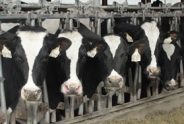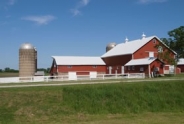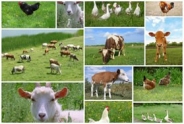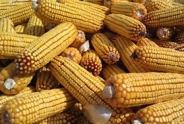Diet and Management Considerations for Emergencies: Reducing Milk Flow
Alycia Drwencke, Dairy Management Specialist
Southwest New York Dairy, Livestock and Field Crops Program

by: Mike Van Amburgh, Tom Overton, and Julio Giordano, Department of Animal Science, Cornell University
Given the unprecedented market conditions and the inability to get milk processed effectively in the short-term, processors are asking dairies to reduce milk supply at a time when it is not possible to cull heavily due to decreased meat processing facility capacity for cattle. We are providing these diet and management considerations in an effort to help dairy producers and their advisors (e.g., nutritionists, veterinarians, other consultants) meet this unusual request, while maintaining cow health and working to ensure that cows have the capacity to resume normal milk production relatively quickly once this situation stabilizes. These considerations may fit management for some but not all dairies. Every operation will have to determine what might work best for them under their current management conditions.
Diet Related Strategies
To start, we recommend that the diets are formulated by your nutritionist. We need to ensure that all nutrients other than energy are being balanced according to the energy allowable milk. This is important as we want to ensure when the restrictions are removed, the cows are in good shape to be able to return to normal productivity.
The most logical and cow friendly approach would be to reformulate the diets to increase the amount of forage fed to the cows and reduce starch and sugar accordingly. In order to do this, forage inventories need to be measured, as you do not want to run out of forage prior to harvesting first cutting.
The decision to make changes negatively affecting milk yield in the high cows will be herd dependent as the most effective strategy is to limit the later lactation cows through nutritional strategies. The following strategies are not stage of lactation dependent, but the implementation might be.
The optimum aNDFom intake is 1.2% of body weight (BW) which for a 1,650 to 1,750 lb cow would be 20 to 21 lb. At 60 lb of dry matter intake that would be 33 to 35% aNDFom as a standard formulation. If you are not at that level of aNDFom, the first step is to formulate in
that range assuming forage inventories will allow for that increase, otherwise increasing non-forage fiber sources would work. At the same time, reduce starch content of the diet to 20% or less while maintaining rumen nitrogen levels to keep the microbes in positive N balance. It is important to balance metabolizable protein (MP) allowable milk to predicted metabolizable energy (ME) allowable milk to maintain normal milk composition. It is also important to make sure minerals and vitamin levels are maintained to ensure good health.
For the post-peak cattle, generally greater than 120 to 150 DIM and pregnant, the aNDFom can be formulated up to 38% of the diet in an effort to limit energy intake and reduce milk yield while keeping the rumen full of fiber. Again, reduce the starch and non-forage fiber sources and maintain MP and minerals and vitamins at the level that matches the ME allowable milk.
Management Strategies
Obviously, culling problematic cattle is the best strategy, but again this capacity is currently reduced due to decreased meat processing facility capacity issues. Reducing overcrowding to no more than 115% to 120% is one approach. Another is to set an upper limit on SCC and cull chronically high cows. Finally, any cows requiring more than three services to attain pregnancy would also be good candidates for culling at this point in time.
Another non-dietary management option to immediately reduce herd milk production is to dry off pregnant cows greater than 200 DCC, especially cows that became pregnant later in lactation and have long DIM, or cows below a milk yield threshold that will be farm-dependent. Certainly, cows that are likely lower margin cows based upon estimated Income Over Feed Cost are good candidates. Before doing this, ensure there is adequate pen space available to provide reasonable cow comfort, potentially convert late lactation milking group pens to additional far-off dry cow pens, and provide a low energy, high fiber dry cow diet to avoid too much BW accumulation since these cows will have longer dry periods.
Another option is switching from 3X to 2X milking. An important consideration for this strategy is to start with the fresh cows up to 21 DIM and the later lactation cows (>150 DIM). Changing the cows in peak production will cause stress and previous experiences suggest if they are near peak or just post-peak, intra-mammary pressure will be quite high causing significant discomfort in the cows. We have observed herds that made this change in the cows at peak milk yield and they were uncomfortable, do not lay down, leak copious amounts of milk and there are large increases in SCC as the gland is put under such stress. To mitigate this, it would be better
to change the diet first to reduce the nutrient supply to start to lower milk yield and then make the switch after a few weeks. From our perspective and from the options discussed, decreasing milking frequency will result in the longest lag in terms of the herd returning to normal milk production, so it is our less preferred option.
We want to emphasize that these approaches are intended to be for short-term conditions and if properly applied should not have long-term consequences on overall lactation performance other than the change to 2X milking. If nutritional changes are implemented to reduce milk output, reversing the process should be conducted over a couple weeks to allow the rumen to adjust to the higher starch, lower aNDFom diets.
Diet and Management Considerations for Emergencies (pdf; 286KB)
Upcoming Events
Crops, Cows & Critters - Southwest New York Dairy, Livestock & Field Crops Newsletter Sponsorship
December 19, 2025
Our two forms of publications feature research-based and timely information from our four specialists, listed to the right, along with local event notifications and Cornell University outreach. This information is provided to participants who range from dairy, livestock, and field crops producers to agricultural suppliers and consultants.
Weekly Email Update: Shared with 625+ households who have signed up with our program.
Monthly Paper Mailer: To reach our stakeholders and farmers who lack internet access, we send out a monthly mailer where your company's logo and contact information would be featured with a mailing list of 330+ households.
If you sponsor our weekly and monthly publications you reach approximately 955 households.
Visit our website to view our newsletters!
2025 Cornell Food Beverage & Animal Feed Manufacturer Survey
December 19, 2025
Industry and Educational Advocates for New York State's Food, Beverage, and Animal Feed Manufacturing industries:
As you know, NYS has a diverse food and beverage manufacturing industry, in both the types of industries that exist and the wide distribution of firms by scale. Many manufacturing firms have strong backward linkages to agricultural production sectors in the state that support both farm-level and downstream food industry firms and consumers. In collaboration with the New York State Department of Agriculture and Markets, a team from Cornell University's Charles H. Dyson School of Applied Economics and Management has recently rolled out the 2025 New York State Food, Beverage, and Animal Feed Manufacturer Survey. The industry will benefit from an updated assessment of the industry that informs private and public investments and opportunities to support firm growth and improved profitability.
Cornell Organic Field Crops & Dairy Conference
March 6, 2026
Waterloo, NY
Farmers, researchers, educators, and agricultural service providers from across the Northeast are invited to the 2026 Cornell Organic Field Crops & Dairy Conference, held Friday, March 6, 2026, from 8:00 a.m. to 4:30 p.m. at the Lux Hotel & Conference Center in Waterloo, N.Y.
Co-hosted by New York Soil Health and Cornell CALS, the annual conference brings together leaders in organic grain, dairy, and livestock systems to share practical tools, new research, and farmer-tested strategies to support resilient and profitable organic production.
Announcements
No announcements at this time.





